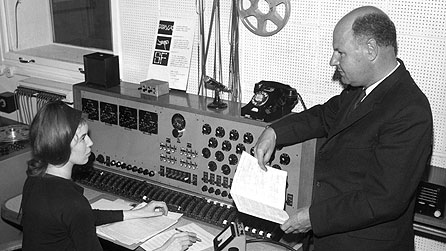A nice 30-minute radio documentary on famous phone phreaker Josef Carl Engressia, aka Joybubbles, with audio from his “Stories & Stuff” call-in recordings and interviews featuring John “Captain Crunch” Draper and “Jack the Ripper.”
Tag: audio
-
A Call from Joybubbles – BBC Radio 4
-
Bell Labs Hamlet from 1885

Seen above is a green disc, wax on brass, with an early recording of Hamlet’s “To be or not to be…” soliloquy, that likely hasn’t been heard in over 125 years. Created by Alexander Graham Bell’s Volta Laboratory in the late 19th Century and sent to the Smithsonian for archiving as they were created, the paranoid Bell failed to provide a playback mechanism for these discs, for fear that his competitors would appropriate his innovations.
Researchers at the Lawrence Berkeley National Laboratories are working on recovering these early audio recordings with a system called IRENE/3D that creates 3D optical scans of the old record-like discs:
Using methods derived from our work on instrumentation for particle physics we have investigated the problem of audio reconstruction from mechanical recordings. The idea was to acquire digital maps of the surface of the media, without contact, and then apply image analysis methods to recover the audio data and reduce noise.
The nifty thing about this form of hands-off scanning is that it can accommodate many types of otherwise mechanically incompatible media, from discs made of metal or glass to wax cylinders (quick, someone set this up to scan the Lazarus bowl!!). The 18-second snippet of Hamlet audio from the green disc above (maybe the voice of Bell himself?) has been posted on YouTube, or you can download more examples from the project in WAV and MP3 format.
(Via PhysOrg)
-
Making of Pharcyde Drop
The behind-the-scenes of one of my favorite Spike Jonze music videos, Pharcyde’s Drop (original video). The group had to learn to rap backwards to create the right lipsync for the effect, so Jonze hired a professional linguist to help transcribe the reversed audio track!
-
Delia Derbyshire Interview

The BBC will be airing a never-before-seen interview this week with Delia Derbyshire, the woman who co-composed and performed the original Doctor Who theme, probably the most famous piece of purely electronic music. For a great account of the production (no synths back then, only novel, painstaking work involving test tone equipment, razor blades and tape!), check out Mark Ayres’s A History of the Doctor Who Theme.
(The interview will air on Inside Out, November 15 at 7:30pm on BBC One – not sure when/if those of us not in the UK will be able to see it, though…)
-
Somewhere between Mozart and Bach
From Scientific American’s Observations blog, a report on a shared emotional code between music and speech:
Almost everyone thinks “Greensleeves” is a sad song—but why? Apart from the melancholy lyrics, it’s because the melody prominently features a musical construct called the minor third, which musicians have used to express sadness since at least the 17th century. The minor third’s emotional sway is closely related to the popular idea that, at least for Western music, songs written in a major key (like “Happy Birthday”) are generally upbeat, while those in a minor key (think of The Beatles’ “Eleanor Rigby”) tend towards the doleful.
The tangible relationship between music and emotion is no surprise to anyone, but a study in the June issue of Emotion suggests the minor third isn’t a facet of musical communication alone—it’s how we convey sadness in speech, too. When it comes to sorrow, music and human speech might speak the same language.
Or to quote Nigel Tufnel: “It’s part of a trilogy, a musical trilogy I’m working on in D minor which is the saddest of all keys, I find. People weep instantly when they hear it, and I don’t know why.”
-
Yukikaze
-
Pallophotophone
The world’s only working (modern) Pallophotophone plays 80-year-old NBC radio broadcasts:
The pallophotophone was an early audio recorder created by GE researcher Charles Hoxie in 1922. Rather than using magnetic wire or lacquer disks, the device captured audio waveforms on sprocketless 35 mm film as a series of 12 parallel tracks reflected from a vibrating mirror. It was used to record some of the world’s oldest surviving radio broadcasts on Schenectady, New York radio station WGY between 1929 and 1931.
As a forgotten optical medium, I guess its more modern analog would be laserfilm discs. Sort of working along the right path, but just not practical compared to other media coming out at the time. There’s more about the rediscovered pallphotophone recordings on the GE Reports blog.
(Via Coudal)
-
Sonar
Sonar from Renaud Hallée on Vimeo.
Sonar by Renaud Hallée. Hypnotic music visualization (keyframe animated rather than generative, though). Reminds me of a cross between a backwards Osu! Tatakae! Ouendan and my favorite NASA video of all time, the Huygens Probe Descent Camera.
(Via Kitsune Noir)
-
Potemkin Army

The Discover blog reports on a Potemkin army:
Russian balloon maker Rusbal is working on an order from the country’s defense ministry to supply full-scale inflatable military models. The realistic-looking hardware is used in battlefield positions and to protect Russian strategic installations from surveillance satellites, distracting snoops and protecting real combat units from strikes. They can look like real vehicles in the radar, thermal, and near infra-red bands, so they’d even look right through night-vision goggles.
And now from Shakespeare’s Macbeth (Act V Scene IV — you know, the cool part where the incoming army disguises itself as the Birnam forest):
MALCOLM
Let every soldier hew him down a bough
And bear’t before him: thereby shall we shadow
The numbers of our host and make discovery
Err in report of us.Nothing much new, then. Simple visual misdirection is the magician’s greatest asset.
See also:
- Edison’s Warriors, a great article in Cabinet about the U.S. 3132nd Signal Service Company in WWII, a sonic deception team that created strategic disruption using wire and tape recordings with acoustical engineering help from Bell Labs
- Operation Bertram
- The Ghost Army
-
User guided audio selection (.mov)
Research video demonstrating an ability to automatically select individual elements of a recorded song (like the vocal track, guitar solo, ringing cellphone, etc) by singing, whistling, or even Beavis & Butthead style grunting in imitation. Not 100% perfect, but it’s very clever. (I wish the video was embeddable…)
Here’s a link to the original paper (PDF) presented to at the 2009 ACM User Interface Software and Technology symposium.
